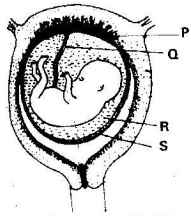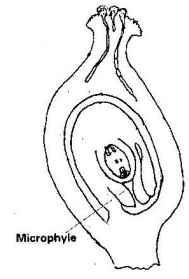Questions
- At what stage of mitosis do chromosomes replicate to form daughter chromatid? (1 mark)
- Fill in the blank spaces in the statement below
After fertilization of an ovule _________ develops into a testa and _________ develops into a testa and _____________ develops into endosperm. ( 2 marks) - State the difference between the composition of maternal blood entering the placenta and material blood leaving the placenta ( 3 marks)
- After four months of pregnancy the ovaries of a woman can be removed without terminating pregnancy. However during the first four months of pregnancy the ovaries must remain intact if pregnancy is to be maintained. Explain these observations ( 3 marks)
- Name two mechanisms that prevent self pollination in flowers that have both male and female parts ( 2 marks)
- State three characteristics that ensure cross pollination takes place in flowering plants ( 3 marks)
- Give a reason why it is necessary for frogs to lay many eggs ( 1 mark)
- A flower was found to have the following characteristics
- Inconspicuous petals
- Long feathery stigma
- Small light pollen grains- What is the likely agent of pollination of the flower? ( 1 mark)
- What is the significance of the long feathery stigma in the flower ( 1 mark)
- State two ways by which the human Immuno Deficiency virus (HIV) is transmitted other than sexual intercourse? ( 2 marks)
- Explain why sexual reproduction is important in organisms ( 3 marks)
- State two disadvantages of self- pollination ( 2 marks)
- The chart below shows the number of chromosomes before and after cell division and fertilization in a mammal.
- What type of cell division takes place at Z? ( 1 mark)
- Where in the body of a female does process Z occur? ( 1 mark)
- On the chart indicate the position of parent and gametes ( 2 marks)
-
- What is meant by the terms
- Epigynous flower ( 1 mark)
- Staminate flower (1 mark)
- How are the male parts of wind- pollinated flowers adapted to their function? (4 marks)
- What is meant by the terms
- Name the part of a flower that developed into:
- Seed (1 mark)
- Fruit (1 mark)
-
- State two processes which occur during anaphase of mitosis ( 2 marks)
- What is the significance of meiosis? (2 marks)
-
- Explain how the following prevents self- pollination:
- Protoandry ( 1 mark)
- Self- sterility ( 1 mark)
- Give three advantages of cross- pollination ( 3 marks)
- Explain how the following prevents self- pollination:
- The diagram below represents a human foetus in a uterus

- Name the part labeled S ( 1 mark)
-
- Name the types of blood vessels found in the structure labeled Q (2 marks)
- State the difference in composition of blood in the vessels named (b) (i) above ( 2 marks)
- Name two features that enable the structure labeled P carry out its function (2 mark)
- State the role of the part labeled R ( 1 mark)
- The diagram below represents a stage during cell division

- Identify the stage of cell division ( 1 mark)
- Give three reasons for your answer (a) (i) above ( 2 marks)
- Name the structure labeled M ( 1 mark)
- State two disadvantages of sexual reproduction in animals ( 2 marks)
-
- What is meant by the following terms?
- Protandry ( 1 mark)
- Self- sterility ( 1 mark)
- The diagram below shows a stage during fertilization in plant

- Name the parts labeled Q, R, and S ( 3 marks)
- State two functions of the pollen tube ( 2 marks)
- On the diagram, label the micropyle ( 1 mark)
- What is meant by the following terms?
-
- Describe how insect pollinated flowers are adopted to pollination (6 marks)
- Describe the role of each of the following hormones in the human menstrual cycle.
- Oestrogen
- Progesterone
- Luteinizing hormone ( 3 marks)
- Describe the role of hormones in the human menstrual cycle (20 marks)
- What part does the placenta play in the
- Nutrition of the embryo
- Protection of the embryo ( 4 marks)
Answers
- Prophase
- Integuments, triploid nucleus
- - Blood entering placenta has more oxygen, more food substances, less nitrogenous wastes and less carbon dioxide.
- Blood leaving placenta has less oxygen, less food substance, more carbon dioxide and nitrogenous wastes. - Corpus luteum in the ovary secretes progesterone, which maintains pregnancy/development of uterus after four months pregnancy is maintained by progesterone form placenta.
- - Protandry / protogyny / male and female parts mature at different times
- Stigma positioned higher than stamen
- Incompatibility /sterility. - - Presence of special structures that attract agents of pollination.
- Protandry /protogyny - - To increase the chances of fertilization and survival of species.
-
- Wind
- To enable it trap pollen grains in the air.
- - Blood transfusion
- Use of unsterilized instruments / sharing (contaminated) instruments.
- Infected mother to foetus; infected mother to newborn. - Bring about change or genetic material, which leads to variation that enables organisms to exploit new environment resistance to disease.
- - Lack of variations
- Lack of hybrid vigour
- Disadvantageous traits are retained within species. -
- Meiosis
- Ovary
- n- gametes
2n- parents
-
- Conditions where other floral parts arise / positioned above the ovary / inferior ovary.
- Male flower
- -Large anthers loosely attached to the filament to be easily shaken in the wind.
- Small / smooth / light pollen grains – easily carried by wind.
-
- Ovule
- Ovary
-
- - Sister Chromates separates.
- Chromatids start moving to opposite poles with centromere first. - - Ensure that gametes formed have half the number of chromosomes found in original cell.
- Formation of sex cells.
- Leads to variation of genetic material during crossover.
- - Sister Chromates separates.
-
- Protoandry Stamens with pollen grains matures before carpel (stigma) of the same flower.
- Self-sterility Pollen grain of anthers cannot grow into pollen tube on the stigma of the same flower.
- - Mixing of genetic composition of different plants.
- Offspring produced has high yield.
- Offspring is more resistant to disease and adverse conditions.
-
- Amnion
-
- – Umblical vein
- Umblical artery - – Umblical vein – rich in nutrients and oxygen.
- Umblical artery – rich in CO2 and waste like urea.
- – Umblical vein
- - Has thin membrane to reduce diffusion distance.
- Has villi which increase surface area for exchange.
- Highly vascularized. - - Cushions foetus against shock
- Supports the foetus
- Keeps foetus moist (prevent dehydration)
-
-
- Anaphase I
- - Homologous chromosomes separate at the equator.
- Chromosomes start migrating to opposite poles
- Sister chromatids attached at the centromere.
- Spindle fibers.
-
- - Harmful characteristics from the parents may be passed on to the off springs.
- Takes a longer time
- Few offsprings are produced at a time. -
-
- Protandry Stamens mature and pollen grains are shed off before the stigma matures.
- Self sterility Pollen grains from the anthers cannot grow on the stigma of the same flower or plant.
-
- Q- Antipodal cells
R- Polar body / polar nucleus
S- Egg cell - Path through which the male gametes reach the embryo sac to enhance fertilization.
- Prevent other pollen grains from developing into pollen tubes hence no multiple fertilization of embryo sac.
- Q- Antipodal cells
-

-
-
-
- Large brightly coloured corolla / inflorescence / forests / tracts to attract insects.
- scented to attract insects
- Have secreted nectar to attract that direct flowers secrete nectar to attract insects.
- Pollen grains rough/spiky sticky surface to stick on insect’s body.
- Special shaped corolla tube to enable the insect land.
-
- Repair / heal endometrium / wall of uterus, which is destroyed in menstruation. Stimulates pituitary gland to produce the luteinising hormone
- Stimulates the thickening of the uterus, increases the blood supply to the endometrium. Inhibits the production of follicle stimulating hormone
- Responsible for maturation of the graafian follicle / causes ovulation. Stimulates corpus luteum to secrete progesterone.
-
- - Interior lobe of pituitary glands secretes follicle stimulating hormones (FSH). FSH causes Graafian follicle to develop in the ovary. It also stimulates tissues of ovary / all of graafian follicle to secrete oestrogen.
- Oestrogen causes repair /healing of uterine wall; oestrogen stimulates interior lobe of pituitary to produce Luteinsing Hormone which causes ovulation. It also causes graafian follicle to change into corpus luteum and stimulates corpus luteum to secrete progesterone.
- Progesterone causes proliferation of uterine wall in preparation for implementation. Oestrogen/progesterone inhibits the production of FSH by interior lobe of pituitary thus no more follicles develops and production reduces.
- In the next two weeks, progesterone level lowers and inhibits production of LH from interior lobe of pituitary.
- The corpus luteum stops secreting progesterone and menstruation occur when the level of progesterone drops. Interior lobe of pituitary start secreting FSH again. -
- It forms a large surface area for the diffusion of nutrient from the maternal blood to the foetal blood. Glucose, amino acids and salts are transferred.
- The placenta isolates the foetus from the higher blood pressure of the mother and from direct connection of the two blood systems. Excretion materials can easily pass from foetus to mother.
Join our whatsapp group for latest updates
Tap Here to Download for 50/-
Get on WhatsApp for 50/-
Download Reproduction in Plants and Animals Questions and Answers - Biology Form 3 Topical Revision.
Tap Here to Download for 50/-
Get on WhatsApp for 50/-
Why download?
- ✔ To read offline at any time.
- ✔ To Print at your convenience
- ✔ Share Easily with Friends / Students


